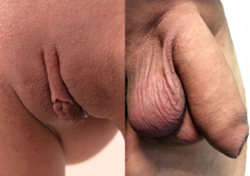This article needs additional citations for verification .(August 2021) |
| Human reproductive system | |
|---|---|
Internal genitalia of a human female (left) and male (right). | |
 External genitalia of an adult female (left) and male (right). | |
| Details | |
| Identifiers | |
| Latin | systemata genitalia |
| TA98 | A09.0.00.000 |
| TA2 | 3467 |
| FMA | 7160 75572, 7160 |
| Anatomical terminology | |
The human reproductive system includes the male reproductive system, which functions to produce and deposit sperm, and the female reproductive system, which functions to produce egg cells and to protect and nourish the fetus until birth. Humans have a high level of sexual differentiation. In addition to differences in nearly every reproductive organ, there are numerous differences in typical secondary sex characteristics.
Contents
Human reproduction usually involves internal fertilization by sexual intercourse. In this process, the male ejaculates semen and sperm through his erect penis into the female's vagina. A small proportion of the sperm pass through the cervix into the uterus and then into the fallopian tubes for fertilization of the ovum. Only one sperm is required to fertilize the ovum. Upon successful fertilization, the fertilized ovum, or zygote, travels out of the fallopian tube and into the uterus, where it implants in the uterine wall. This marks the beginning of gestation, better known as pregnancy, which continues for around nine months as the fetus develops. When the fetus has developed to a certain point, pregnancy is concluded with childbirth, involving labor. During labor, the uterine muscles contract, and the cervix dilates typically over a period of hours, allowing the infant to pass from the uterus through the vagina. [1] Human infants are entirely dependent on their caregivers and require parental care. Infants rely on their caregivers for comfort, cleanliness, and food. Food may be provided by breastfeeding or formula feeding. [2]






